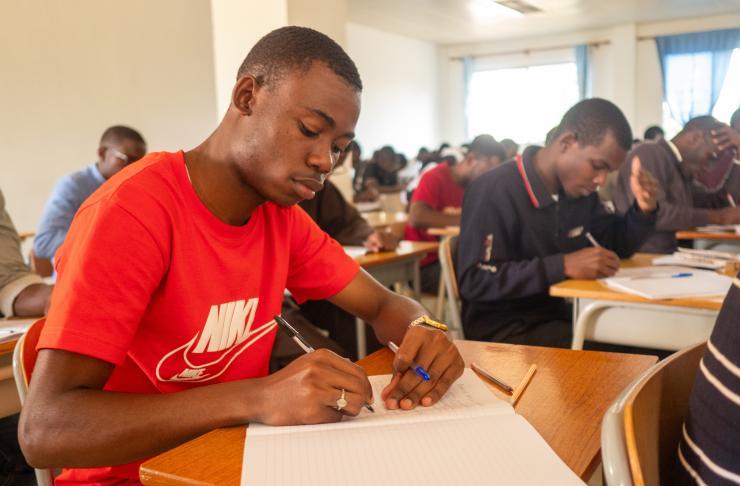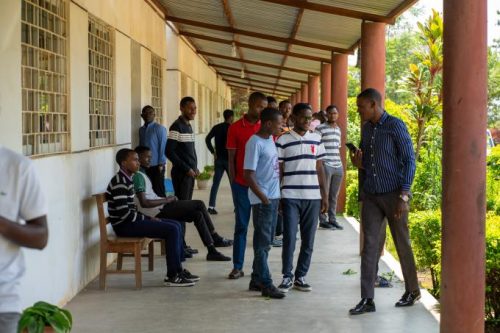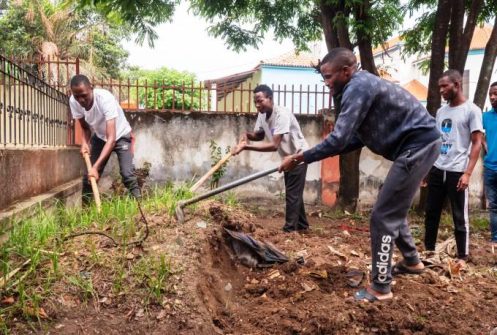Angola. Cristo Rey Seminary. A formation centre of excellence.

Since its foundation by the Spiritan Missionaries in 1928, the Cristo Rey Major Seminary of Huambo has trained dozens of bishops, hundreds of priests and many young people who today serve Angolan society. We paid it a visit.
Not far from the Cathedral of Our Lady of the Immaculate Conception in the centre of Huambo stands the Cristo Rey Major Seminary. We were welcomed by Father Agostinho Ekongo, a professor of Church History. As he shows us around, we are reminded of the importance of the Huambo Seminary for the Church and Angolan society. He tells us: “The history of this training centre is inextricably linked to the Spiritan Missionaries, who arrived for the first time in the territory of present-day Angola in 1866 and who soon discovered the need to train the native clergy for the success of their evangelising mission. In 1921 a minor seminary was opened in the Sambo mission. However, 1928 is the year commemorated as the foundation year of the Major Seminary of Christ the King. The first group of young Angolans began their philosophy studies in the Galangue mission. The centre would then move to Ganda and then to Quipeio, until its definitive transfer to Huambo in 1947.”

Over the years, the Cristo Rey Major Seminary has maintained its prestige as a training centre of excellence.
Seven years earlier, in 1940, a concordat had been signed between Portugal and the Holy See which allowed the creation of three large dioceses in the country, including that of New Lisbon, the name
given to Huambo at the time.
In January 1941, Msgr. Daniel Gomes Junquiera, a Portuguese Spiritan missionary, was consecrated as the first diocesan bishop. According to Fr. Ekongo, “Bishop Junqueira had in his heart the desire to form an Angolan Church and to equip it with indigenous clergy, so during his 30 years of episcopate he consolidated the seminary of Huambo, which trained many priests for the diocese of Huambo and other locations of Angola”.Between the country’s independence in 1975 and the start of the civil war led by the MPLA and UNITA, Cristo Rey Major Seminary continued to play a fundamental role in the training of the Angolan clergy. The Marxist MPLA government expropriated all the seminaries, but, as Professor Ekongo points out, “Inexplicably and fortunately because even today the motivation is not well known, the Huambo seminary was not affected and remained the only one in the country to function throughout the 1980s.”
Initially, philosophy and theology students studied in the same structure, but in 1992, given the increase in the number of students from every corner of the country, it was decided to separate philosophy from theology. With independent management, the two centres share the same name and form a single large structure.

About 256 diocesan seminarians are pursuing their studies.
This year, 256 diocesan seminarians and seminarians from religious congregations, 148 of whom are in philosophy and 107 in theology,
are pursuing their studies.
Over the years, the Cristo Rey Major Seminary has maintained its prestige as a training centre of excellence and continues to welcome seminarians from 12 other Angolan dioceses.
The Angolan church is growing strongly, but the number of priests and religious is still limited in proportion to its needs. Mgr. Zeferino Zeca Martins, a Divine Word missionary who has been Archbishop of Huambo since October 2018, says: “The priority is the training of the clergy because we have 58 parishes and 41 missions and pastoral centres, and we need priests to take care of them adequately. There are currently 130 diocesan priests, 23 of whom are outside Angola for studies. It’s obvious there aren’t enough of them.”The Archdiocese of Huambo, which coincides territorially with the province of the same name, has a population of over four million inhabitants, with 63% Catholics, according to the archbishop’s statistics. Mgr. Zeca adds: “The Christian communities are growing and we are planning to open another four or five parishes, but I have no priests to send them.”

Seminarians in their work after class. The Angolan church is growing strongly, but the number of priests and religious is still limited in proportion to its needs.
The prelate’s words are at the same time a sign of joy but also of regret. The archbishop is convinced that “the specialization studies of priests is important to better serve the faithful”. For this reason, after a few years of pastoral service in the diocese after their time in the seminary, he does not hesitate to send them to Europe, even if they spend a few years away from the diocese. It is a necessary evil because according to Msgr. Zeca, “They must be well prepared to accompany the training of seminarians, hold courses, coordinate the professionalisation of the Caritas service, the diocesan secretariat and the other diocesan offices that we are creating, such as those of Economy and Communication.”
In the Archdiocese of Huambo, there are various congregations. Besides the Spiritan Missionaries, there are Benedictines and Capuchins, Passionists, Dominicans, the Brothers of the Holy Family, and more recently the Salesians.
An important aspect for Msgr. Zeca is the formation of laypeople. The archbishop recognizes that “the formation of lay people is still very lacking and that it is necessary to work on this aspect so that they can take their place in the Church.”
Enrique Bayo
Photos: José Luis Silván Sen



